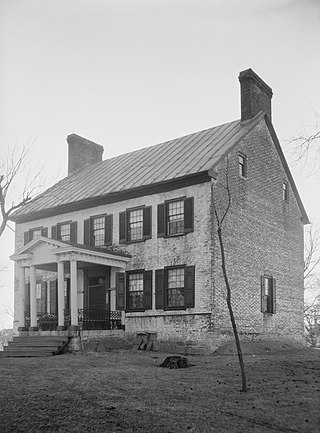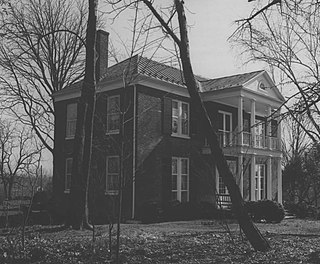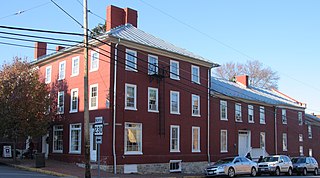
Shepherdstown is a town in Jefferson County, West Virginia, United States, located in the lower Shenandoah Valley along the Potomac River. Home to Shepherd University, the town's population was 1,531 at the time of the 2020 census. The town was established in 1762 along with Romney; they are the oldest towns in West Virginia.

Marshlands, also known as the James Robert Verdier House, is a historic house at 501 Pinckney Street in Beaufort, South Carolina. Built about 1814, it is a high quality and well-preserved example of early Beaufort architecture, showing both Adamesque and West Indian stylistic influences. It is also notable as a home of Dr. James Robert Verdier, who discovered a treatment for yellow fever. It was designated a National Historic Landmark in 1973 for its architectural significance.

The Van Swearingen-Shepherd House, also known as Bellevue, is a Colonial Revival mansion in Shepherdstown, West Virginia that is home to the descendants of Captain Thomas Shepherd, founder of Shepherdstown. The house, situated on a bluff overlooking the Potomac River, was built in 1773 by Thomas Van Swearingen as a single-story stone house. His son, also named Thomas Van Swearingen, was a US Representative. The Shepherd family acquired the house in 1900, when Henry Shepherd III bought the house as a wedding present for his bride Minnie Reinhart, whose grandfather was Thomas Van Swearingen. That year, the Shepherds gave a dinner party on the lawn for William Jennings Bryan during his second presidential campaign. The house remains in the hands of the Shepherd family.

Elmwood is a Federal style house near Shepherdstown, West Virginia. Located on land claimed in 1732 by Edward Lucas II, it was built in 1797 by his son, Edward Lucas III. During the Civil War the house was used as a field hospital. It remained in the Lucas family until 1948.

Beverley, also known as Bullskin, is a farm near Charles Town, West Virginia that has been a working agricultural unit since 1750. The narrow lane that leads from U.S. Route 340 to the Beverley complex was, in the 18th and 19th centuries a toll road. The main house was built about 1800 by Beverley Whiting on the site of a c. 1760 stone house. The house is Georgian influenced Federal style, with a later Greek Revival portico. A number of outbuildings dating to the original 1760 house accompany the main house.
Glenburnie is an historic farm complex located between Shepherdstown, West Virginia and Shenandoah Junction, West Virginia. The house was built by James Glenn in 1802, completing the barn two years later.

Morgan's Grove is a rural historic district near Shepherdstown, West Virginia. The area is noted for its abundant springs. Several historic houses and farms are in the district, including:

Falling Spring at Morgan's Grove is part of a related complex of buildings and lands associated with the Morgan family and other prominent members of the Shepherdstown, West Virginia, community.

The Morgan-Bedinger-Dandridge House — first known as Poplar Grove, then Rosebrake or Rose Brake — is part of a group of structures affiliated with the Morgan's Grove rural historic district near Shepherdstown, West Virginia. The property was known as "Poplar Grove" until 1877.

Shepherd's Mill is a gristmill in Shepherdstown, West Virginia, located on Town Run just as it descends to the Potomac River. The mill was built some time prior to 1739 by Thomas Shepherd, Sr. (1705-1776) — founder and namesake of the town — as a two-story structure. The original millwheel was probably a wood overshot wheel. The present 40-foot-diameter (12 m) Fitz Water Wheel Company steel overshot wheel was built in 1894; with the addition of a third story in the late 19th century, the mill is more representative of that era.

Rumsey Hall, also known as the Entler Hotel, is an historic building in Shepherdstown, West Virginia. The building is located in the center of the Shepherdstown Historic District and is a composite of six separate phases of construction. The earliest portion was built in 1786, and was the home belonging to Christian Cookus. This section burned in 1912. This section was separated by a narrow passage from the core of the hotel property, first started in the 1790s by owner Daniel Bedinger. This Federal style structure was expanded to the corner sometime before 1809, with a further addition along Princess Street by 1815. A kitchen and a carriage house completed the complex. Significant interior features remain. In 1809 a store was opened in the corner building, operated by James Brown. At about the same time, the Globe Tavern opened, offering overnight accommodations. In 1815, Bedinger sold the property to James Brown and Edward Lucas for $6,000. In 1820 it was again sold, to Thomas Crown of Washington, D.C., for $4000. By this time the tavern was managed by Thomas James and the hotel by Daniel Entler. In 1823, Daniel Entler became the manager of the entire property. The Entlers managed the properties until 1873, when they moved to Piedmont, West Virginia, while retaining ownership of the hotel.
Rose Hill Farm, also known as the James-Marshall-Snyder Farm, is a double-pile, two story brick farmhouse with Greek Revival features near Shepherdstown, West Virginia. A log house on the property was built circa 1795, while the brick house was built around 1835. It is believed that the log house was built by Samuel Davenport, who leased the land from the Stephen family. In 1821 the property was sold to Thomas James.

The Captain William Lucas and Robert Lucas House, also known as Linden Spring, is a large stone house near Shepherdstown in Jefferson County, West Virginia, United States. It was built circa 1783 for Captain William Lucas, a Revolutionary War soldier. Lucas' son, Robert Lucas was born here and became a Governor of Ohio and the first Territorial governor of Iowa.
Fruit Hill, also known as the Robinson-Andrews-Hoxton House, is a Greek Revival house near Shepherdstown, West Virginia. The original two-story stone house on the property was probably built by Henry Cookus circa 1766. This house was built over a watercourse, assuring a reliable supply of water on what was then the frontier. The main Greek Revival house was built in the 1830s by Archibald Robinson, and the house remains in the hands of the family. The interior of the house includes a three-story open staircase.

Cold Spring is a house near Shepherdstown, West Virginia, childhood home to two United States Representatives. The house was built by Edward Lucas III and his son, Robert in 1793.
Boidstones Place, also called Greenbrakes and Fountain Rock, was built in 1766 by Thomas Boydston near Shepherdstown, West Virginia on land he was granted by Thomas Fairfax, 6th Lord Fairfax of Cameron. In a dispute with Fairfax and Joist Hite over lands he had acquired along the Terrapin Neck on the Potomac River, Boydston lost most of his lands, which were acquired by Abraham Shepherd. The property formed a portion of the Shepherd's holdings along Shepherd Grade, which were primarily devoted breeding race horses. Some of the property was annexed to the adjoining Wild Goose property, owned by R.D. Shepherd, who had a racetrack there. In 1851 R.D. Shepherd gave Boidstones to his nephew and namesake R. D. Shepherd, Jr. who built the main Greek Revival section of the house. The property was sold out of the Shepherd family in 1886, but was returned to the Shepherds in 1916 for use as a summer place.

The Shepherdstown Historic District comprises the historic core of Shepherdstown, West Virginia. The town is the oldest in West Virginia, founded in 1762 as Mecklenburg. No structures are known to exist from the time before the town became known as Shepherdstown. The historic district is concentrated along German Street, the main street, with 386 contributing resources and 69 non-contributing elements. The chief representative period is the late 18th century, with many Federal style brick houses. German Street is also furnished with 19th-century "street furniture" such as metal fences, mounting blocks, wooden pumps and mature trees.

The Middleway Historic District comprises sixty major buildings from the late 18th century and early 19th century in Middleway, West Virginia. Middleway was a crossroads town on the Shepherdstown-Berryville road and the Charles Town turnpike. The town was established by John Smith, Sr. and Jr., along with son and brother Rees Smith, who had established grist and hemp mills by 1734 along Turkey Run. The town was not, however, officially established until 1798. The town never followed up on its original growth, allowing the older stone, brick and log houses to be preserved.

Rockland is the home of Virginia's Rust family, near Leesburg, Virginia. The property housed slaves to work their farm. The property was acquired by General George Rust from the heirs of Colonel Burgess Ball in 1817. General Rust built the present brick residence about 1822, incorporating an older frame house as a rear service wing.

The James Rumsey Monument, also known as Rumsey Monument Park, is a municipal park and former West Virginia state park in Shepherdstown, Jefferson County in the U.S. state of West Virginia. The park overlooks the Potomac River. It commemorates local inventor James Rumsey and his successful public demonstration of his steamboat invention on the Potomac in 1787. The monument consists of a 75 ft (23 m) column of Woodstock granite, which is capped with a globe and stands atop a tall, concrete plinth consisting of a 40 sq ft (3.7 m2) plaza.

















